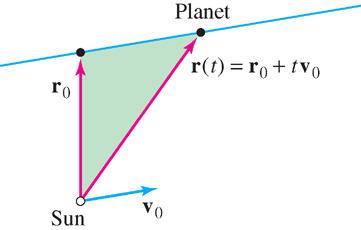13.20 CHAPTER REVIEW EXERCISES
Question 13.353
Determine the domains of the vector-
r1(t) = 〈t−1, (t + 1)−1, sin−1 t〉

Question 13.354
Sketch the paths r1(θ) = 〈θ, cos θ〉 and r2(θ) = 〈cos θ, θ〉 in the xy-plane.
Question 13.355
Find a vector parametrization of the intersection of the surfaces x2 + y4 + 2z3 = 6 and x = y2 in R3.
Question 13.356
Find a vector parametrization using trigonometric functions of the intersection of the plane x + y + z = 1 and the elliptical cylinder  in R3.
in R3.
In Exercises 5–
Question 13.357

Question 13.358

Question 13.359

Question 13.360

Question 13.361

Question 13.362

In Exercises 11–

Question 13.363

Question 13.364

Question 13.365

Question 13.366

Question 13.367
Calculate
Question 13.368
Calculate
Question 13.369
A particle located at (1, 1, 0) at time t = 0 follows a path whose velocity vector is v(t) = 〈1, t, 2t2〉. Find the particle’s location at t = 2.
Question 13.370
Find the vector-
Question 13.371
Calculate r(t) assuming that

Question 13.372
Solve r″(t) = 〈t2 − 1, t + 1, t3〉 subject to the initial conditions r(0) = 〈1, 0, 0〉 and r′(0) = 〈−1, 1, 0〉
Question 13.373
Compute the length of the path

Question 13.374
 Express the length of the path r(t) = 〈ln t, t, et 〉 for 1 ≤ t ≤ 2 as a definite integral, and use a computer algebra system to find its value to two decimal places.
Express the length of the path r(t) = 〈ln t, t, et 〉 for 1 ≤ t ≤ 2 as a definite integral, and use a computer algebra system to find its value to two decimal places.
Question 13.375
Find an arc length parametrization of a helix of height 20 cm that makes four full rotations over a circle of radius 5 cm.
Question 13.376
Find the minimum speed of a particle with trajectory r(t) = 〈t, et−3,e4−t〉.
Question 13.377
A projectile fired at an angle of 60° lands 400 m away. What was its initial speed?
773
Question 13.378
A specially trained mouse runs counterclockwise in a circle of radius 0.6 m on the floor of an elevator with speed 0.3 m/s while the elevator ascends from ground level (along the z-axis) at a speed of 12 m/s. Find the mouse’s acceleration vector as a function of time. Assume that the circle is centered at the origin of the xy-plane and the mouse is at (2, 0, 0) at t = 0.
Question 13.379
During a short time interval [0.5, 1.5], the path of an unmanned spy plane is described by

A laser is fired (in the tangential direction) toward the yz-plane at time t = 1. Which point in the yz-plane does the laser beam hit?
Question 13.380
A force F = 〈12t + 4, 8 − 24t〉 (in newtons) acts on a 2-
Question 13.381
Find the unit tangent vector to r(t) = 〈sin t, t, cos t〉 at t = π.
Question 13.382
Find the unit tangent vector to r(t) = 〈t2, tan−1 t, t〉 at t = 1.
Question 13.383
Calculate κ(1) for r(t) = 〈ln t, t〉.
Question 13.384
Calculate  for r(t) = 〈tan t, sec t, cos t〉.
for r(t) = 〈tan t, sec t, cos t〉.
In Exercises 33 and 34, write the acceleration vector a at the point indicated as a sum of tangential and normal components.
Question 13.385

Question 13.386

Question 13.387
At a certain time t0, the path of a moving particle is tangent to the y-axis. The particle’s speed at time t0 is 4 m/s, and its acceleration vector is a = 〈5, 4, 12〉. Determine the curvature of the path at t0.
Question 13.388
Parametrize the osculating circle to y = x2 − x3 at x = 1.
Question 13.389
Parametrize the osculating circle to  at x = 4.
at x = 4.
Question 13.390
If a planet has zero mass (m = 0), then Newton’s laws of motion reduce to r″(t) = 0 and the orbit is a straight line r(t) = r0 + tv0, where r0 = r(0) and v0 = r′(0) (Figure 1). Show that the area swept out by the radial vector at time t is  and thus Kepler’s Second Law continues to hold (the rate is constant).
and thus Kepler’s Second Law continues to hold (the rate is constant).

Question 13.391
Suppose the orbit of a planet is an ellipse of eccentricity e = c/a and period T (Figure 2). Use Kepler’s Second Law to show that the time required to travel from A′ to B′ is equal to


Question 13.392
The period of Mercury is approximately 88 days, and its orbit has eccentricity 0.205. How much longer does it take Mercury to travel from A′ to B′ than from B′ to A (Figure 2)?